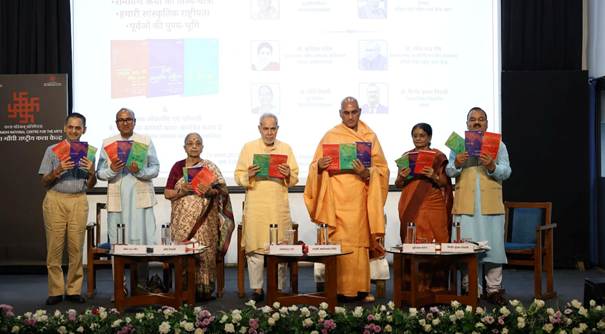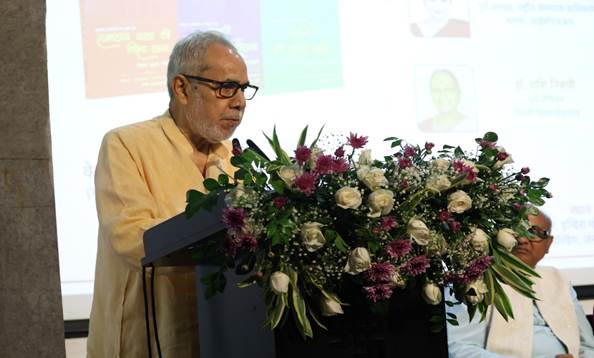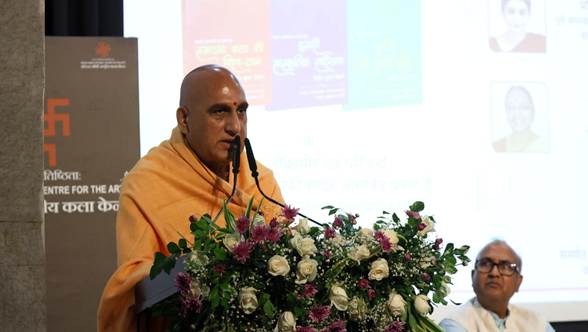Ministry of Culture
“Ramayana is the Passport of Indian Culture” – Mahamandaleshwar Swami Avadheshanand Giri
प्रविष्टि तिथि:
24 AUG 2025 8:00PM by PIB Delhi
The Kala Nidhi Division of the Indira Gandhi National Centre for the Arts (IGNCA) under the aegis of the Ministry of Culture organized a prestigious event for the release of the cultural trilogy authored by renowned educationist and writer Dr. Vinod Kumar Tiwari. The three books, ‘Ramayana Katha ki Vishva-Yatra’, ‘Hamari Sanskritik Rashtriyata’,and ‘Purvajon ki Punya-Bhoomi’ were formally launched, followed by an insightful discussion on their content. Scholars described these works as an important contribution to the deep discourse on Indian culture and nationalism. The trilogy has been published by Motilal Banarsidass Publishers.

The chief guest of the program was Acharya Mahamandaleshwar Swami Avadheshanand Giri, the head of Juna Peeth, and the event was chaired by Shri Ram Bahadur Rai, President, IGNCA Trust. Notably, Swami Avadheshanand Giri Ji has also written the foreword for all three books. Other distinguished speakers included Prof. Sushmita Pandey, former Chairperson of the National Monument Authority and Member of ICHR; Prof. Ramesh Chandra Gaur, Head of the Kala Nidhi Division and Dean (Administration), IGNCA; and Dr. Shashi Tiwari, former faculty member at the University of Delhi. Speakers emphasized that these works represent a remarkable contribution toward preserving Indian knowledge systems, cultural heritage, and national unity. The program commenced with the auspicious sound of the conch and a Vedic invocation, followed by a welcome address and introduction of guests by Prof. Ramesh Chandra Gaur.

In his keynote address, Acharya Mahamandaleshwar Swami Avadheshanand Giri stated: “The Ramayana is history. In India, there are two texts considered historical—Ramayana and Mahabharata. These are historical texts. In our tradition, history is neither an ‘ism’ nor a myth. Terms like ‘myth’ or ‘mythology’ are words of the English language. ‘Ism’ means something speculative, not true, imaginary, and perhaps never existed in the past—a mere assumption. Similarly, myth does not connote truth. Our culture is not mythology; it is truth, eternal, and its origin lies in the Rigveda.” He further remarked, “Our culture is Sanatan (eternal truth). It is the root of democratic values, dialogue, mathematics, science, numerals, zero, and the decimal system. This discussion is not confined to books; it is a proclamation of the Indian philosophy of life. Dr. Vinod Tiwari has done an extraordinary job in this regard.”

In his presidential address, Shri Ram Bahadur Rai referred to the foreword written by Swami Avadheshanand Giri for the books and said: “The Ramayana expresses Indian culture in its most sublime form. The Ramayana is the passport of Indian culture. Once, someone asked Pandit Ramkinkar Upadhyay, ‘What is the best commentary on the Gita?’ I am bringing up the Gita here because Swamiji has connected us to the Vedas-the root. And when you connect with the Vedas, you will understand 2025 in a clearer sense. Ramkinkar Ji said, ‘In my view, the best commentary on the Gita is the Ramcharitmanas.’ Lokmanya Tilak wrote his commentary on the Gita, ‘Gita Rahasya’, in Mandalay Jail, which was translated into Hindi in 1915 by Madhavrao Sapre, a journalist and disciple of Tilak. Whatever the Gita conveys is elaborated in Gita Rahasya.” He further said “Sri Aurobindo praised Gita Rahasya. Mahatma Gandhi, in his speeches at Banaras, Kanpur, and Pune after Tilak’s demise, said that no greater research on the Gita had been done till then. He even doubted if it would ever happen in the future. I would like to request that Vinod Tiwari Ji bring Tilak Maharaj’s Gita into a similar accessible language. My congratulations to Vinod Ji for these three remarkable books.”
Introducing the books, Dr. Vinod Kumar Tiwari spoke about the spread of the Ramayana tradition in Southeast Asia. He stated that the Ramayana is a symbol of Indian culture and that Sanskrit is not only the language of science but also the language of mathematics. Highlighting the global influence of the Ramayana, he mentioned that the original name of Jakarta, the capital of Indonesia, was Ayodhyakarta, which eventually transformed into Jakarta.
Prof. Sushmita Pandey observed that the book Ramayana Katha ki Vishva-Yatra stands out for Dr. Vinod Tiwari’s extensive discussion on South and Southeast Asia, but more significantly for his innovative approach in describing how the people of Indian origin in the Caribbean islands, known as Girmitiyas, managed to propagate the Ramayana despite immense hardships. She noted that this effort is truly pioneering. According to her, culture is essentially a form of spiritual consciousness, symbolically expressed, and this is clearly reflected in the Ramayana. She further added that there is a profound connection between culture and the Ramayana. Referring to Southeast Asia, she emphasised the region’s ancient ties with India. Archaeologist I. K. Sharma has pointed out that these connections go back to the third millennium BCE, as evidenced by Indian symbols on ceramic objects and the presence of glass and stone beads from India in Iron Age burial sites. These links became even stronger during the Gupta period.
Dr. Shashi Tiwari remarked that all three books are extremely useful, engaging, and interesting, containing essays written in diverse styles. She noted that defining nationality has always been considered a challenging task. Many scholars have tried, but no precise definition has been established. For example, some have suggested that a nation is defined by people of the same race living together, or people of the same religion, or those speaking the same language. However, such criteria cannot apply to India, as it is home to numerous races, religions, and languages. In this context, she found Vasudev Sharan Agrawal’s book Prithvi-Putra particularly insightful. The title is based on a mantra from the Atharvaveda, “Mata Bhumih Putro’ham Prithivyah” (The earth is my mother, I am her son). On this basis, he defined a nation as comprising a specific territory, its people, and their culture. While the culture of the people may be diverse, it unites them together, forming cultural nationality, which faces no barriers. Religion, science, knowledge, philosophy, art, music, and literature all fall under the realm of culture, and throughout history, India has continually experienced this sense of unity.
In his welcome address, Prof. Ramesh Chandra Gaur outlined the structure of the programme, stating that there are 121 languages in India spoken by more than ten thousand people each, yet the Ramayana has not been translated into all of them. He emphasised that if such Indian texts are not translated into every Indian language, this knowledge will not reach the common people, which is the need of the hour. He concluded by expressing gratitude to the guests, speakers, and attendees. The event, held at IGNCA’s Samvet Auditorium, witnessed the presence of a large number of scholars, researchers, students, and literature enthusiasts.
****
Sunil Kumar Tiwari
pibculture[at]gmail[dot]com
(रिलीज़ आईडी: 2160426)
आगंतुक पटल : 342